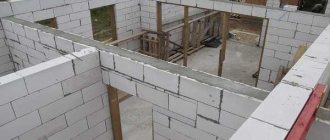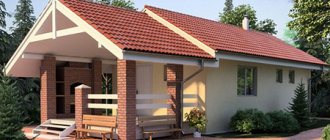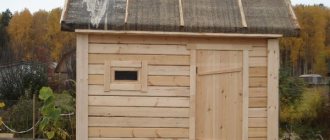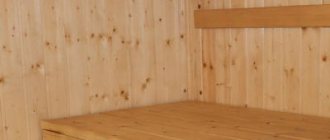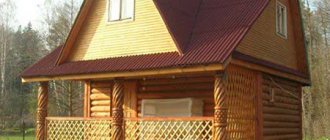Technologies in construction are developing by leaps and bounds. New materials are emerging that make it possible to build faster, without losing quality. And although aerated concrete is not an innovation - it is already three or four decades old - bathhouses have not been built from it before: this material has a fairly high hygroscopicity. But new impregnations have appeared that can significantly reduce the amount of moisture that the material absorbs. But even without impregnation, using modern vapor and waterproofing, you can achieve good results. The average lifespan of a bathhouse made of foam blocks is about 20-30 years. If you're happy with this, start looking for a project.
A gas silicate bathhouse can be built “with one hand”, and the process goes quickly: the blocks are large but light
You just have to remember that aerated concrete is produced using two technologies. In the production of some, hardening occurs in an autoclave - these are gas-concrete and gas silicate. When producing others (foam concrete), a foaming agent is simply added, then the foamed solution is poured into molds and hardens in air.
Autoclaved cellular concrete is considered to be of higher quality. An autoclave is not a cheap piece of equipment, so you can’t make the material using a homemade method. This is reflected in the cost - gas silicate is more expensive than foam concrete - but the geometry of the material and its quality are usually much better. Since it is desirable to make the seams between the blocks as thin as possible, the geometry is very important. Therefore, when purchasing, look for gas silicate blocks with the least deviations. Even if they are more expensive, you will save as a result: the glue costs a lot, if you can make a 1-2 mm seam, its consumption will be small. In addition, with such a seam there will be less heat loss, which means that it will be possible to make a smaller layer of insulation (if they are insulated) and less fuel will be consumed to heat the bath.
It is easy to distinguish gas silicate: due to the fact that lime is the binding element in it, it has a white color. The rest of the porous concrete is gray.
The gas silicate block is easy to distinguish: by color
Planning projects
Sometimes when building gas silicate baths, difficulties arise with the layout and location of the premises. The idea can be taken from ready-made projects and, if necessary, modified slightly.
If we are talking about small baths, then they most often have three rooms: a relaxation room, which is combined with a locker room, a washing room and a steam room. Some have a veranda or porch attached.
Layout options for a 6 by 3 bath made of gas silicate blocks
Medium-sized baths may already have a dedicated changing room, as well as a vestibule or hall. A vestibule or hall is desirable, since if the front door leads directly to the rest room, then in winter every opening of the door threatens a sharp drop in temperature. Therefore, at least a small vestibule is needed. If it is not possible to fence it off from the rest room, then you can attach it outside. Let it be small, but closed and insulated.
No one argues about whether a locker room is needed (if space allows). The dispute is about where her door should go. There are actually two options: in the sink and the rest room. Both are imperfect. If the doors of the locker room open into the rest room, after undressing you will have to go through it. If there is no one there, that’s one thing, but if people are resting, that’s another. The second option - the doors open into the washing room - usually does not have this drawback. But in such a room the clothes will be damp. So you have to choose: either a naked fashion show or raw clothes. Although the problem of dampness can be solved by making good forced ventilation in the locker room: the supply hole is at the bottom, the exhaust hole is at the top, and there is an exhaust fan in it.
Bathhouse layout 6*4.45 m
In its entirety, the bathhouse has a large length of 7.4 m since it has a veranda attached to it. It consists of three rooms:
Project of a gas silicate bathhouse 6x4
- rest room 13.66 m2;
- sink area 4 m2;
- steam room 5.8 m2;
- veranda 4 m2.
In this case, a vestibule can be made by moving the steps and installing doors. And the locker room can be fenced off at the end of the rest room opposite the entrance. Then, really, you will have to install a smaller window, or make two small ones: one in the rest room, the second in the locker room.
Bathhouse 5*5 with terrace
In this bathhouse layout, a rather large terrace is made of gas silicate - it has an area of 7.5 square meters. (Projects of bathhouses with terraces are here) Of the interior spaces, the steam room has the largest size - 5.8 m2, all the others are smaller. Non-standard solution. Usually the steam room is made small. But why not? The stove is installed in the wall between the steam room and the washing room.
Projects for a 6x4 gas silicate bath
Premises area:
- rest room/locker room 3.8 m2;
- sink 4.5 m2;
- steam room 5.8 m2;
- veranda 7.5 m2.
There are no options for changes here: the small size of the premises does not allow any liberties. But on the veranda you can have a pleasant time in the warm season.
Project bathhouse 6*6 made of gas silicate blocks with a terrace
In this layout, 6*6 is the size of the bathhouse itself, and the terrace is another two meters. In total, in terms of plan, the entire building will occupy 6*8 meters. The approach is more standard: the largest area is in the rest room. The steam room and the washing room are almost equal in size.
Project of a foam concrete bathhouse with a terrace and a large relaxation room
The stove is positioned so that it is heated from the rest room. The decision is ambiguous. As far as heating is concerned, everything is fine: the rest room will also be warm. But if you need to add firewood, and there are no people outside the steam room in the bathhouse, you will have to go through the shower and go to the rest room. Nothing terrible, but not everyone will like this option. Although installing a stove with a remote firebox is the most popular option recently.
Area of premises in a 6 by 6 bath:
- recreation room 16.2 m2;
- sink 5.5 m2;
- steam room 5.2 m2;
- hall 3.2 m2;
- terrace 12.3 m2
Drawing of a gas silicate bath
Do-it-yourself 6x4 sauna. Projects and their implementation
Despite the external simplicity of this building, its construction should be approached extremely responsibly. This is especially true for the choice of building material. Experienced professionals advise choosing one of the following options:
- wood (timber or log);
- frame;
- brick;
- foam blocks.
Each material has advantages and disadvantages. In addition, the speed of construction of the building and the final cost of the project depend on the choice of construction technology. The choice of material must be made before the start of the project, thanks to this it is possible to make adjustments to the drawing of the bathhouse.
Bathhouse made of logs or timber
In modern construction, more than a dozen materials are used to construct buildings, but wood occupies a leading position, as it did many centuries ago.
A log or timber bathhouse has several features:
- Environmental friendliness. Wood is a 100% natural material and therefore has no harmful effects on human health. In addition, steam rooms made of logs have always been in demand in Russian villages.
- Construction speed. When using already processed logs or timber, you can build a bathhouse in a short time.
- Savings on finishing. A wooden bathhouse looks aesthetically pleasing and does not need finishing.
The cost of such building material is relatively high, but a 6x4 bathhouse is small in size and will not require large financial costs.
In terms of technical characteristics, timber and logs have no differences. In this case, the log has a round shape, and the timber has a square shape. This affects the appearance of the building. In addition, when using timber, a more precise fit is achieved, which reduces costs.
Frame-based sauna
A frame steam room can be a cheaper alternative to a bathhouse made of timber or logs. The peculiarity of this structure is that a frame made of wooden blocks is first installed on the foundation. After this, the base is sheathed with a “pie”, which consists of internal and external cladding, insulation, and a waterproofing layer.
This technology has several advantages:
- Saving on foundation. The light weight of the structure allows the bathhouse to be erected on stilts.
- Effective heat retention. This point is only possible with good thermal insulation.
- Short construction time. You can completely build a 4 by 6 steam room along with the foundation in 3-4 days.
- Low cost. Compared to wood, frame technology requires less costs.
One of the disadvantages is the shrinkage of the frame. In this case, cracks and deformed areas appear on the sheathing panels.
Brick bath
For the construction of steam rooms, brick is in less demand than wood, but its features are also worth studying. There are several advantages of using this:
- Fire safety. Brick has increased fire resistance compared to solid wood and frame buildings.
- Duration of operation. Brick buildings do not require repairs for up to 50 years.
- Environmental friendliness. The composition contains components that are safe for human health.
- Wide choice of architectural solutions. 4x6 baths can be not only 4-corner boxes, but also have a complex shape.
The disadvantages of brickwork include the following features:
- Increased heat capacity. Heating such a room will require more time and resources than heating a log or frame building.
- Moisture absorption. Bricks are a hygroscopic material, so they need increased insulation.
- The need to lay a strip foundation. This increases construction costs.
- High price for bricks.
Bathhouse made of blocks
A steam room made of foam blocks is well suited for DIY construction. This can be explained by several advantages of this building material:
- Construction speed. 1 foam block is equal in size to 13 bricks, so the laying process takes less time. With the optimal size of the bathhouse, construction can be completed in 1-1.5 weeks.
- Possibility to use immediately after construction. The blocks do not shrink.
- No harmful chemicals in the composition.
- Energy intensity. Premises of this type retain heat for a long time.
- Increased fire safety.
- Resistant to mold and parasites (unlike wood).
Features of construction from gas silicate
Pouring the foundation and erecting walls during the construction of a bathhouse is no different from similar processes during the construction of a house. The foundation for bathhouses is often made of strip foundations, the depth is below freezing of the soil. The width of the tape depends on the size of the block that will be used during construction.
Adhesive for gas silicate - cellular betor. Diluted with water. Dosage and order are indicated on the package
Particular attention must be paid to horizontal waterproofing. Previously, and even today, roofing felt was most often laid in two layers. But roofing felt is bituminous mastic applied to a layer of construction cardboard. At one time it was good material, and there was simply no alternative to it. But it has one very significant drawback: it does not have the longest service life (35 years depending on conditions). Today there are similar rolled materials made using practically the same technology, but based on fiberglass (more durable) or fiberglass. It is better to use them - they are more elastic and do not lose their properties for a long time.
Place the gas silicate on a special glue, which is diluted with water to a semi-liquid state. Only the bottom row is laid on cement-sand mortar. All the rest - on a thin layer of glue (no more than 5 mm, and better - 1 mm). Every 3-4 rows it is recommended to lay two reinforcement bars (ribbed with a diameter of 12-14 mm). The grooves are cut out for them using a circular saw, an angle grinder or a hand-held wall cutter, which is made specifically for foam concrete.
Pay attention to how the reinforcement is laid at the junction of the walls - it is bent and a whole frame is laid
The adhesive composition is applied using a carriage or a special trowel - a scoop with teeth. Clean the block from dust and dirt, apply glue to the end where it will be joined to the next block, and carefully place it. Correct the position with a rubber mallet.
The masonry is carried out similarly to brick - with ligation - covering the seam of the bottom row with the body of the block in the next row. To ensure that the rows of masonry are even, use a building level and pull the cord - the mooring. The verticality of walls and corners is controlled by a plumb line.
When laying blocks, the seams are made very thin - no more than 5 mm. This allows you to save money on glue, but also increases the thermal insulation characteristics of the wall. The glue conducts heat well, so the smaller the cold bridges, the better. The layer is applied using a special trowel or carriage. If necessary, you can level it with a large notched trowel, which is usually used by tilers.
Apply glue to the back of the laid block and to the side of the one standing next to it.
For more information about tools for working with foam blocks, read the article “How to choose trowels and other tools”
Since gas silicate material is soft, they cannot bear any serious loads. Therefore, when installing the floor, the logs rest on the foundation. It is specially made wider than the blocks, and the edge of the wall is aligned with the edge of the tape. In some cases, the blocks are moved 10 centimeters outward. It turns out that the wall seems to hang over the foundation. This simple technique increases the internal dimensions of the premises. And the resulting depression is then covered with insulation (expanded polystyrene boards) and waterproofing. Read about foundation waterproofing here.
The situation with the roof is standard: a thick wooden beam - a mauerlat - is laid on the top row, and the entire system is already attached to it. There is a second option: filling the armored belt. Then formwork is installed or special U-shaped blocks are used, into which four interconnected reinforcement bars are placed (longitudinal thickness 10-12 mm, transverse thickness 6-8 mm).
According to the thickness of the wall. Recommended - 25-35 cm, depending on the region. In terms of density, gas silicates of two grades D400 and D500 are most often used. The first has a lower density, the second has a higher density, and accordingly the D500 is more durable. But in terms of thermal insulation characteristics, D400 is better - walls built using it are warmer.
Table of characteristics of gas silicate of different densities
Features of foam concrete
Foam concrete is a cellular material that appeared on the construction market several decades ago, but continues to be in great demand and is widely used in the construction of premises. For its production, simple technology is used, which reduces the cost of the final product and allows you to produce building materials at home.
Pros and cons of the material
The popularity of foam block is due to its performance properties and advantages. First of all, it is increased thermal insulation and resistance to temperature fluctuations. Experts say that even with constant exposure to high temperatures, the material does not begin to deform and retains its initial strength. It also meets all environmental safety requirements, is not afraid of corrosive or putrefactive processes, and also does not become an object of attack by rodents.
The foam block is lightweight, which reduces the complexity of construction work and simplifies installation. Baths based on this material are characterized by resistance to fire, and this is an important point in compliance with safety standards.
But, in addition to a lot of advantages, the foam block also has disadvantages. Before use, they must be treated with special compounds that provide the required degree of moisture resistance. If you miss this moment, the material will be deformed and quickly lose its presentability.
Despite the affordable cost of raw materials, the installation process can be accompanied by high costs. They are associated with the acquisition of a special adhesive composition, as well as the carrying out of insulation work.
Ventilation
When building baths from any material, the main task is to ensure good drying of all rooms after the bath. Then there will be no problems with fungi and mold.
When building a bathhouse from gas silicate blocks with your own hands, do not forget to leave ventilation holes at the top and bottom of the wall in each room. They can probably be cut out later, but why complicate your life. To prevent suction from them while vaping, they are closed with doors. And they don’t go into the room - they end up under the insulation. Their task is to remove all steam from under the casing after visiting the steam room.
One of the options for external insulation of walls made of foam blocks with subsequent finishing
Foam block construction project
The choice of cellular concrete blocks as the main building material is not accidental. This economical modern building material is characterized by a number of advantages in comparison with other wall materials, such as brick, stone or wooden beams.
Ease of machining
Among the advantages we note the following:
- The price of foam blocks is low, which has a positive effect on the cost of the entire facility;
- A house built using these blocks is characterized by low weight and, as a result, low load on the foundation;
- Walls made of foam blocks have a low degree of thermal conductivity, thanks to which it will be possible to save on heating;
- Foam concrete and building materials based on it “breathe” due to their porous structure. Thanks to this, optimal parameters of moisture content in the air are maintained at home.
- Cellular concrete blocks are easy to process. They are easy to drill and saw, as a result of which the construction process is significantly simplified and cheaper.
Clean masonry of foam blocks without extra effort
Example Project 1
As an example, let's look at the most popular designs of houses made of foam blocks with a bathhouse. In Figure No. 1 we can see a typical solution suitable for building a small country house with a steam room and shower.
The advantage of such planning is that in a limited area you can place not only a small bathhouse, but also a full-fledged relaxation room and even a terrace for comfortable spending time in the warm season (see also the article “Bathhouse with a veranda: features of projects”).
Considering that the house is planned to be built from foam concrete, a monolithic strip shallow foundation with sides of 6 and 8 meters can be used as a foundation.
Of course, such a small house cannot be considered as a full-fledged home, but as a building for spending weekends and holidays outside the city, such a house looks very attractive.
Sample Project 2
A similar structure is shown in Figure 2. This project is slightly larger in size than the first sample, but also includes only those rooms that are necessary for short-term temporary residence and for the operation of the washing department and steam room.
The advantage of the project is that all rooms have similar sizes, therefore, you can use the steam room and shower in comfortable, uncrowded conditions.
Due to the relatively small dimensions and light weight of building materials, this project can also be built with your own hands on a shallow strip foundation for a bathhouse.
Sample Project 3
However, all these projects of houses and bathhouses made of foam blocks are small and suitable exclusively for short-term living. Let's consider the plan of a full-fledged house with a steam room and shower.
This project provides for a full-fledged living room and a relaxation room, in addition there is a kitchen and a spacious hall. But, most importantly, the project includes a sauna, a washing room and a separate bathroom, which makes a temporary or all-season stay in the house most comfortable.
Where to order a project
Where can I order a project, and is it needed at all?
As already mentioned, having a project guarantees a number of advantages, including:
- Having a general idea of how to build the planned structure;
- Convenience of planning estimates of building materials and, as a result, the ability to prevent their overexpenditure;
- The ability to adjust the timing of the construction process, which results in an increase in labor productivity;
- No difficulties in registering real estate and registering it with the cadastral authorities.
Project documentation is, in fact, instructions according to which a house is built. Therefore, this plan, along with the location of rooms and individual utility rooms, should contain information about the thickness of the walls, the method of arranging the floor, roofing system, etc.
Thus, from all of the above, we can conclude that the development, preparation, and subsequently approval of project documentation should be carried out exclusively by professionals with specialized qualifications.
You can order projects of residential buildings made of foam blocks with a bathhouse directly on the Internet. To do this, just leave a request on the website of specialized design bureaus.
As a rule, the development of drawings is carried out taking into account all regulatory requirements and based on the personal wishes of the customer. The development of a project for your new home will be free if a construction organization acts as a contractor.
Insulation
The outside of a bathhouse made of gas silicate blocks is insulated depending on the region. In central Russia, 10 cm of basalt wool is enough. In more northern regions, more is needed, in southern regions less. The use of mineral wool is associated with certain difficulties: it is afraid of moisture and loses its properties when wet. And if it freezes wet, it will simply crumble. But that's not all. Since the foam block is quite hygroscopic, it also needs to be protected from moisture. Therefore, before laying the insulation, it is treated with impregnation such as Penetron or Kalmatron. After drying, you can begin thermal insulation.
Based on all this, it makes sense to spend money on the purchase of extruded polystyrene. It itself does not absorb water or conduct it, has low thermal conductivity, and is not damaged by rodents and insects. This one material, laid without cracks, will be both hydro- and thermal insulation.
The sheathing is stuffed on top of the insulation, and then the sheathing is added to it. You can attach a painting mesh to polystyrene foam and plaster over it - if this type of finishing appeals to you more.
Options for finishing and insulating foam concrete walls
The inside of the steam room will be insulated as follows (from the wall to the steam room):
- cement-based impregnation that reduces hygroscopicity;
- block 50*40 m;
- there is a heat insulator between them;
- steam and hydrobarrier - usually foil film (you glue the joints and fasteners with special tape - buy it in the same place where you buy the film);
- counter-lattice at least 2.5 cm thick;
- lining.
In other rooms, including the washing room, insulation may not be installed. If you also cover the washing area with clapboard, then a vapor barrier film should remain. It may no longer be foil-coated (this is mainly only for steam rooms), but both it and the impregnation should be there. In the remaining, “dry” rooms, the impregnation remains (the humidity is still high), the lathing, and the lining is stuffed to it.
The walls are covered with sheathing - preparation for laying insulation
The ceiling insulation in the steam room is standard (from bottom to top, when viewed from the steam room):
- lining;
- vapor barrier film (foil);
- rough ceiling;
- insulation from the attic.
Moreover, a ventilation gap is required between the lining and the vapor barrier. It is organized using a counter-lattice. Read more about insulating the ceiling of a steam room in the article “How to insulate the ceiling in a bathhouse with your own hands”
Interior of a bathhouse with a swimming pool
The choice of style depends on the preferences of the owners and the harmonious combination of materials. Do not overload the room with decor. The room should have enough space to move around freely.
Popular interior design styles:
- Russian;
- country;
- Mediterranean;
- Oriental.
Pool decoration often includes tiles and mosaics in the following colors:
- blue, light blue, azure;
- beige, brown;
- White gray;
- light green.
People try not to use flashy bright shades of red and purple, since they are visually irritating to a person. To create a relaxing atmosphere, it is better to choose calm pastel colors.
The photo shows an example of decorating a room with a corner pool in a modern style. The ceiling is finished with composite panels with spotlights, so that the lighting is distributed evenly. The floor is ceramic tiles. The doors from the steam room to the pool are glass. On the walls there are panels with a repeating pattern of a sunset on the sea.
Finishing the pool and the area around it with small mosaics remains always relevant.
Here is a half-timbered room with protruding massive beams on the ceiling and panoramic glazing.
The classic clapboard finish will fit into any style. Here the owners decided to add some textiles in the form of white curtains.
The photo above is an example of a small sauna with a square pool. The bathroom is small. The shower room is located in the same room, just separated by a curtain. The steam room is hidden behind a glass door. There was also room for a table with chairs.
This is a combination of different styles. The walls are brick. The ceiling is lined with clapboard. Many windows make the room bright. The pool is oval in shape, finished with porcelain stoneware.
Such a small tank will fit compactly even in a small Russian bathhouse. Large windows offer a beautiful view of the winter forest. The lower part of the walls is lined with stone, the top with decorative plaster.
Finishing in the steam room and washing room
No matter how hard you try to do a vapor barrier, water will still seep under all the layers and settle in the wall. To minimize its amount, it is better to tiled the walls in the washing room. If you are afraid that it will be cold, make a warm floor (you can also use the walls).
In the steam room, also lay the floor and part of the wall - to a height of 10 cm or higher - with tiles. And then there’s the whole “pie” in full.
If you take into account all these nuances when building a gas silicate bathhouse with your own hands, it will delight you for many years.
Foam blocks: features and characteristics
Traditionally, a bathhouse is built from wood materials, such as timber, logs, etc. They are good for everyone, except perhaps the need for constant maintenance, since the wood begins to rot quite quickly under the influence of dampness. Without some care, a wooden bathhouse will very quickly lose its original appearance.
Foam block bath projects
But recently, bathhouses are often built from foam blocks. This material is an excellent alternative to traditional wood, as it has a lot of advantages and in some cases even surpasses wood in its characteristics. A foam block is a block of a certain size made from foam concrete or cellular concrete. It has not been a novelty on the construction market for a long time, but previously it was used much less frequently than now, due to the fact that its main disadvantage - hygroscopicity due to high porosity - has been overcome.
Foam block
However, the presence of porosity is the main feature of such materials. Thanks to it, foam blocks have an excellent level of thermal insulation, are able to perfectly retain heat in any structure, and are not too heavy materials. The pores inside the block can have different sizes and are located randomly throughout its entire interior.
Foam concrete - production process
Roof
The roof has one peculiarity: the roofing material must be light. It could be:
- soft roofing - made of rolled materials or soft bitumen tiles;
- corrugated sheeting;
- metal tiles;
- wooden roof.
The entire system is attached to the Mauerlat, and it is attached to the upper armored belt with long pins. When attaching the rafter system, everything is attached only to the beam. It is not worth attaching to the walls - there is no sense in it: gas silicate cannot withstand long-term point loads, it crumbles and cracks. That’s why an armored belt is needed.
Let's start construction
Layout option.
Laying the foundation - the “heart” of the bathhouse
When building a bathhouse from foam blocks, the most important thing is to lay the foundation correctly.
- It is worth starting with marking the area and digging a trench. To build a small bathhouse 4 x 4 m, you will need a pit 60 cm deep and 30-40 cm wide.
- Then, using a laser level, it is necessary to drive the pins into the corners of the dug pit, as well as in gaps along the entire length of the foundation at a distance of 2 m.
- The next stage consists of making formwork from boards about 30 mm wide each and a frame from reinforcement with a metal thickness of 12 mm. Pour grade 200 concrete into the resulting “mold”. For a small building, 75 cm in height of the base will be sufficient (consumption of 4 cubic meters of concrete). It will take about 10 days for the foundation to harden.
- After which the sewer can be laid. This will require sewer pipes with a diameter of 10 mm and a receiver in the place where, in accordance with the project, the shower will be located.
- Experts recommend insulating the foundation of the bathhouse, since in the warm season it becomes covered with condensation, and its inner surface remains wet all summer. This will soon lead to the destruction of the foundation.
Thermal insulation of the foundation contributes to:
- reducing heat loss;
- ensuring the required stable bath temperature;
- preventing condensation;
- waterproofing protection.
- A mesh is laid at the bottom of the pit and filled with cement with a layer thickness of about 15 cm (consumption of 1 cubic meter of concrete).
Walling
Photo – installation of a stove on a foundation.
First, you should lay the waterproofing according to the scheme: bitumen - roofing felt - bitumen - roofing felt.
To build a bathhouse with your own hands, it is best to use foam blocks of the M25 brand, size 200x300x600 and density D700. The blocks must be placed edge-on on a special bonding adhesive or cement mixture. It is imperative to periodically check the verticality and horizontality of the masonry.
Attention! All actions must begin from the corner: marking the foundation, laying the walls. The verticality of the corner and the horizontality of the foundation must be checked especially carefully, otherwise distortion is inevitable.
Construction of the attic
Construction of a bathhouse.
To build the attic frame, it is necessary to make the most accurate calculation of the load-bearing structures. The basis of the future ceiling will be horizontal rafters, and the walls - vertical posts. In this case, the optimal angle of inclination of the rafters is 30-60 degrees. This is explained by the fact that the larger this range, the less usable area of the attic remains.
The normal width of this room is considered to be 3.5 meters and height 2.3 meters.
The best roof would be a multi-layer broken structure consisting of roofing, waterproofing, insulation, sheathing, vapor barrier and interior decoration.
Vapor barrier: saving ourselves from moisture
The attic above the bathhouse is distinguished by its unusual placement conditions, which are characterized by high humidity.
Therefore, the interfloor pie here should have the following structure:
- vapor barrier: foil or film;
- thermal insulation layer using basalt wool between the rafters;
- ventilated bottom gap, 50 mm thick;
- roofing membrane made of Tyvek, Isospan or Utah;
- ventilation top gap – 50 mm;
- sheathing;
- roof.

